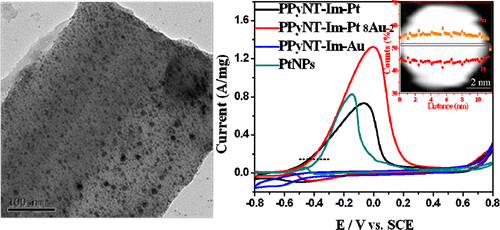PPyNT-Im-PtAu Alloy Nanoparticle Hybrids with Tunable Electroactivity and Enhanced Durability for Methanol Electrooxidation and Oxygen Reduction Reaction
Yingjing Peng (彭颖静), Changhai Liu, Congtao Pan, Lihua Qiu, Suidong Wang, and Feng Yan*(严锋)
ACS Appl. Mater. Interfaces 2013, 5, 2752-2760.
Polypyrrole nanotubes (PPyNTs)/PtAu alloy nanoparticle (NP) hybrids were synthesized in gram-scale byusing covalently attached imidazolium moieties as a linker. The approach involves the surface functionalization of PPyNTs with pendant imidazolium moieties (PPyNT-Im), anion-exchange with Pt and Auprecursors, and followed by the reduction of metal ions to produce the PtAu alloy NPs on the surface of PPyNTs. X-ray diffraction (XRD), X-ray photoelectron spectroscopy (XPS), high-angle annular dark-filed scanning transmission electron microscopy (HAADF-STEM), and elemental mapping showed that both Pt and Au were atomically distributed in the PtAu alloy NPs without phase segregation. The composition of the PtAu alloy NPs can be simply controlled by adjusting the feed ratio in the metal precursor solution. The electrocatalytic properties of prepared PPyNT-Im-PtxAuy (the suffixes x and y represent the relative molar ratio of Pt and Au in the feed, respectively)NP hybrids were determined by the composition of alloy NPs. The Pt-rich NP hybrids, PPyNT-Im-Pt8Au2, showed highly electrocatalytic activity and stability toward the methanol oxidation in both acidic and alkaline solutions, while the Au-rich NP hybrids, PPyNT-Im-Pt2Au8, showed an enhanced catalytic activity and durability upon oxygen reduction. The present study provided a simpleand effectiveapproach for the preparation of PtAu alloy catalysts with controllable composition for high performance fuel cells and electrochemical sensors.

